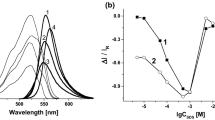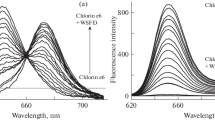Summary
Association has been found to occur in solutions of perfluoroacids as determined by the spectral dye method. Whereas micelles are usually not found in solutions of normal paraffin chain salts with less than six carbon atoms in the chain, there is definite evidence for a critical micelle concentration (CMC) in perfluoroacetic acid solutions. There is a complete loss of color of pinacyanol chloride solutions at concentrations of added perfluoroacids at and above the CMC which is seen to be due to the environment at the surface of the micelles where the dye molecules are bound. Data are presented to show the effect of substitution ofω-hydrogen and chain chlorines on the CMC of fluoroacids and salts. Using a method proposed byDebye, the calculated contribution to the attraction energy (van der Wools' forces) in micelle formation is about 1200 cal per mole per CH2 in paraffin chain salts and about 2000 cal per mole per CF2 in the perfluoroacids, but these values, particularly the latter ones, must be considered to be too high for no correction has been applied for the role of the water molecules and other factors in these calculations. Using some more recent equations, it is possible to obtain values of about 1300 cal/mole per CF2 which is in good agreement with other available data.
Zusammenfassung
Die Spektralfarbenmethode zeigt, daß in Lösungen von Perfluorsäuren Assoziation auftreten kann. Während Mizellen normalerweise nicht in Lösungen von normalen Paraffinkettensalzen mit weniger als 6 Kohlenstoffatomen in der Kette gefunden werden können, ist eine bestimmte Wahrscheinlichkeit für das Auftreten einer kritischen Mizellkonzentration (CMC) in perfluorsauren Lösungen vorhanden. Es tritt ein vollkommener Farbverlust von Pinacyanolchlorid-Lösungen bei Konzentrationen an zugefügten Perfluorsäuren von einer Konzentration gleich oder oberhalb der CMC ein, von welchem nachgewiesen werden kann, daß er der Umgebung mit Zelloberflächen, in der die Farbstoffmoleküle gebunden werden, zuzuschreiben ist. Es werden Daten mitgeteilt, die den Effekt der Substitution des Wasserstoffes und des Chlors der Kette auf die CMC von Eluorsäuren und Salzen zeigen. Unter Verwendung einer vonDebye vorgeschlagenen Methode ergibt die Berechnung der Anziehungsenergie (van der Waal's Kräfte) zur Mizellbildung ungefähr 1200 cal/mol für jede CH2-Gruppe in den Paraffinkettensalzen und ungefähr 2000 cal/mol für jede CF2-Gruppe in den Perfluorsäuren; doch sind diese Werte, besonders die letzteren, als zu hoch anzusehen, da keine Korrektur für die Wirkung der Wassermoleküle und anderer Faktoren in diesen Rechnungen berücksichtigt wurden. Mit Hilfe einiger früherer Gleichungen ist es möglich, Werte von ungefähr 1300 cal/mol für die CF2-Gruppe zu erhalten, die in guter Übereinstimmung mit anderen erreichbaren Daten sind.
Similar content being viewed by others
References
Scholberg, H. M., R. A. Guenther andC. I. Coon, J. Physic. Chem.57, 923 (1953).
Klevens, H. B. andM. Raison, J. Chim. Phys.51, 1 (1954).
Klevens, H. B. andJ. Vergnolle, IInd International Congress of Surface Activity, London, England, April 1957; Gas/Liquid and Liquid/Liquid Interface (London 1958).
Klevens, H. B. andM. Raison, Reports of the Ist World Congress on Surface Active Agents, Section I, page 50 (1954).
Klevens, H. B. andJ. T. Davies, IInd International Congress of Surface Activity, London, England, April 1957; Gas/Liquid and Liquid/Liquid Interface (London 1958).
Sheppard, S. E. andA. L. Geddes, J. Chem. Phys.13, 63 (1945).
Corrin, M. L., H. B. Klevens andW. D. Harkins, J. Chem. Phys.14, 216, 480 (1946).
Klevens, H. B., J. Physic. Chem.51, 1143 (1947).
Raison, M., Compt. rend.235, 1129 (1952).
Salaman, J., J. Gustala andH. B. Klevens (unpublished data).
Colichman, E. L., without correct data.
Debye, P., Ann. N.Y. Acad. Sci.51, 575 (1950).
Ooshika, Y., J. Colloid Sci.9, 254 (1954).
Philipps, J. N., Trans. Faraday Soc.51, 561 (1955).
Simons, J. H., Fluorine Chemistry Vol. 1 (New York 1950). —Scott, R. L., J. Physic. Chem.70, 4090 (1948).
Author information
Authors and Affiliations
Additional information
The principal portion of this work was done at the Laboratoire de Chimie Physique, Institut Pasteur, Paris, France, while the author was an Advanced Research Scholar, 1951–52 under the Fulbright Act.
Rights and permissions
About this article
Cite this article
Klevens, H.B. Association in fluoroacids. Spectral charakteristics of added dyes. Kolloid-Zeitschrift 158, 53–58 (1958). https://doi.org/10.1007/BF01744661
Received:
Issue Date:
DOI: https://doi.org/10.1007/BF01744661




